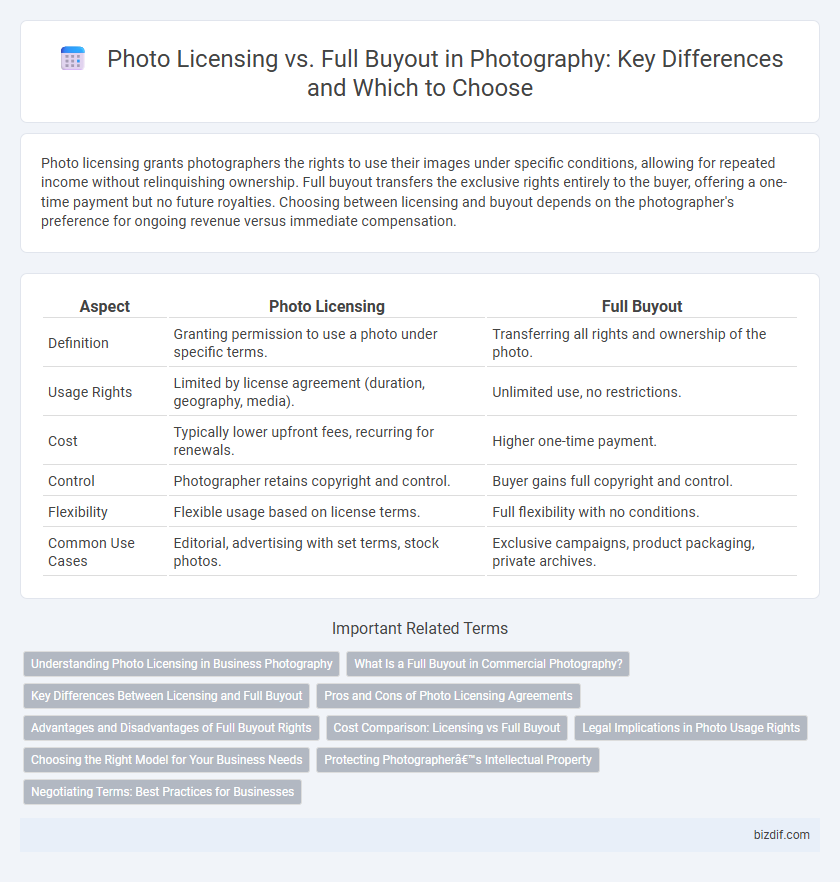Photo licensing grants photographers the rights to use their images under specific conditions, allowing for repeated income without relinquishing ownership. Full buyout transfers the exclusive rights entirely to the buyer, offering a one-time payment but no future royalties. Choosing between licensing and buyout depends on the photographer's preference for ongoing revenue versus immediate compensation.
Table of Comparison
| Aspect | Photo Licensing | Full Buyout |
|---|---|---|
| Definition | Granting permission to use a photo under specific terms. | Transferring all rights and ownership of the photo. |
| Usage Rights | Limited by license agreement (duration, geography, media). | Unlimited use, no restrictions. |
| Cost | Typically lower upfront fees, recurring for renewals. | Higher one-time payment. |
| Control | Photographer retains copyright and control. | Buyer gains full copyright and control. |
| Flexibility | Flexible usage based on license terms. | Full flexibility with no conditions. |
| Common Use Cases | Editorial, advertising with set terms, stock photos. | Exclusive campaigns, product packaging, private archives. |
Understanding Photo Licensing in Business Photography
Photo licensing grants businesses limited rights to use images for specific purposes, durations, and geographic regions, making it a cost-effective option for targeted marketing campaigns. Licensing agreements define usage scope, such as online presence, print materials, or social media, protecting the photographer's ownership while providing flexibility for business needs. Understanding the terms of photo licensing helps businesses avoid legal issues and ensures proper compensation for photographers.
What Is a Full Buyout in Commercial Photography?
A full buyout in commercial photography grants the client exclusive rights to use the image indefinitely without any limitations on time, geography, or medium. This type of licensing transfers all usage rights from the photographer to the client, ensuring the image can be exploited without any further fees or permissions. Full buyouts are ideal for brands seeking complete control and ownership of visual assets for extensive marketing campaigns.
Key Differences Between Licensing and Full Buyout
Photo licensing grants specific usage rights for images under defined terms, allowing photographers to retain ownership while clients receive permission for limited use. Full buyout involves transferring all rights and ownership of the photo to the buyer, enabling unlimited use without further compensation to the creator. Licensing agreements typically include restrictions on duration, geography, or medium, whereas full buyouts remove such limitations for complete control over the image.
Pros and Cons of Photo Licensing Agreements
Photo licensing agreements grant specific usage rights to clients while the photographer retains copyright, allowing multiple revenue streams without relinquishing ownership. These agreements offer flexibility, controlled distribution, and potential recurring income but often limit exclusivity, potentially restricting clients seeking sole usage. Licensing also requires clear terms to avoid misunderstandings about usage scope, duration, and geographic limitations, impacting both parties' expectations.
Advantages and Disadvantages of Full Buyout Rights
Full buyout rights in photography grant the buyer complete, unlimited use of the image without restrictions, allowing for extensive commercial exploitation and modification, which maximizes revenue potential and usage flexibility. However, this option often involves higher upfront costs for photographers and results in the loss of future licensing opportunities, as the original creator relinquishes control over the image. The lack of usage limits can lead to overexposure or misrepresentation of the photograph, impacting the photographer's brand and exclusivity.
Cost Comparison: Licensing vs Full Buyout
Photo licensing offers a cost-effective solution by granting usage rights for a specific duration or purpose, often starting from a few hundred dollars depending on image resolution and usage scope. Full buyout involves a one-time payment ranging from several thousand to tens of thousands of dollars, granting unlimited use and ownership of the image. Choosing between photo licensing and full buyout hinges on budget constraints and the intended long-term value of exclusive image rights.
Legal Implications in Photo Usage Rights
Photo licensing grants specific usage rights to buyers while the photographer retains ownership, limiting legal risks and controlling the scope of distribution. Full buyout transfers all rights to the purchaser, eliminating royalty obligations but transferring future legal liabilities and potential restrictions on usage. Understanding the contractual terms in licensing agreements or buyout deals is crucial to avoid infringement, unauthorized use, or disputes over intellectual property rights.
Choosing the Right Model for Your Business Needs
Photo licensing allows businesses to use images under specific terms and durations, offering flexibility and cost-effectiveness for projects with defined scopes. Full buyout grants complete ownership of the image rights, ideal for long-term use or commercial ventures requiring unrestricted reproduction. Assessing project goals, budget, and usage plans helps determine whether licensing or buyout best aligns with your business needs.
Protecting Photographer’s Intellectual Property
Photo licensing grants clients limited rights to use images while photographers retain ownership and control over intellectual property, ensuring ongoing revenue and protection against unauthorized use. Full buyout transfers all rights to the buyer, often resulting in the photographer losing future control and potential income from the image. Strategic licensing agreements safeguard photographers' creative rights and maintain the value of their work in the market.
Negotiating Terms: Best Practices for Businesses
Negotiating photo licensing terms requires clear definition of usage rights, duration, and territorial scope to protect business interests and budget. Businesses should prioritize exclusive vs. non-exclusive rights, royalty fees, and potential renewals to maximize value while minimizing costs. Documenting all terms in a detailed contract ensures compliance and prevents legal disputes over image usage.
Photo Licensing vs Full Buyout Infographic

 bizdif.com
bizdif.com